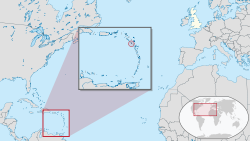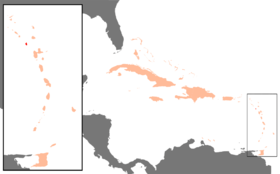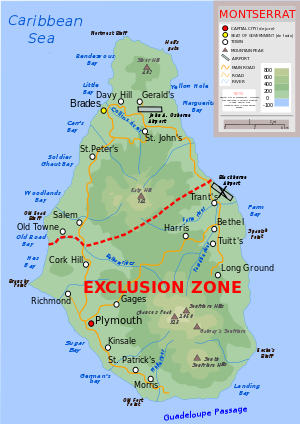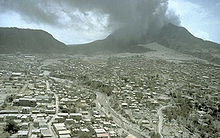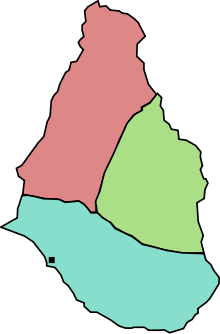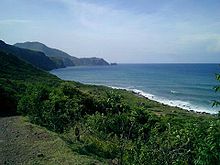
Montserrat
Background Information
This Schools selection was originally chosen by SOS Children for schools in the developing world without internet access. It is available as a intranet download. SOS Children is the world's largest charity giving orphaned and abandoned children the chance of family life.
| Montserrat Overseas territory of the United Kingdom Montserrat
|
||||||
|---|---|---|---|---|---|---|
|
||||||
| Motto: "Each Endeavouring, All Achieving" | ||||||
| Anthem: God Save the Queen | ||||||
|
|
||||||
|
|
||||||
| Capital |
|
|||||
| Official languages | English | |||||
| Ethnic groups () |
|
|||||
| Demonym | Montserratian | |||||
| Government | British Overseas Territoryb | |||||
| - | Monarch | Elizabeth II | ||||
| - | Governor | Adrian Davis | ||||
| - | Premier | Reuben Meade | ||||
| - | Responsible Ministerc ( UK) | Mark Simmonds MP | ||||
| Establishment | ||||||
| - | English control established | 1632 | ||||
| Area | ||||||
| - | Total | 102 km2 ( 219th) 39 sq mi |
||||
| - | Water (%) | negligible | ||||
| Population | ||||||
| - | 2012 estimate | 5,164 ( 218th) | ||||
| GDP ( PPP) | 2006 estimate | |||||
| - | Total | $43.500 million ( not ranked) | ||||
| - | Per capita | $8,500 ( not ranked) | ||||
| Currency | East Caribbean dollar ( XCD) |
|||||
| Time zone | ( UTC−4) | |||||
| Calling code | +1 664 | |||||
| ISO 3166 code | MS | |||||
| Internet TLD | .ms | |||||
| a. | Abandoned in 1997 following a volcanic eruption. Government buildings are currently located in Brades, making it the de facto capital. | |||||
| b. | Representative democratic parliamentary dependency under constitutional monarchy. | |||||
| c. | For the Overseas Territories. | |||||
Montserrat (pron.: / m ɒ n t s ə ˈ r æ t /) is a Caribbean island that is a British Overseas Territory. It is located in the Leeward Islands, part of the chain of islands known as the Lesser Antilles, in the West Indies. The island of Montserrat measures approximately 16 km (9.9 mi) long and 11 km (6.8 mi) wide, with approximately 40 kilometres (25 mi) of coastline. Montserrat is nicknamed The Emerald Isle of the Caribbean both for its resemblance to coastal Ireland and for the Irish ancestry of some of its inhabitants.
On July 18, 1995, the previously dormant Soufrière Hills volcano became active. Eruptions destroyed Montserrat's Georgian era capital city of Plymouth and two-thirds of the island's population was forced to flee. The volcanic activity continues to the present, the affected areas currently being mostly in the vicinity of Plymouth, including its docking facilities, and also on the eastern side of the island in the area around the former W. H. Bramble Airport, the remnants of which were buried by flows from volcanic activity on February 11, 2010.
An "exclusion zone" extending from the south coast of the island north to parts of the Belham Valley has been imposed because of the size of the existing volcanic dome and the resulting potential for pyroclastic activity. Visitors are generally not permitted entry into the exclusion zone, but an impressive view of the destruction of Plymouth can be seen from the top of Garibaldi Hill in Isles Bay. Relatively quiet since early 2010, the volcano continues to be closely monitored by the Montserrat Volcano Observatory.
A new town and port is being developed at Little Bay in the northwest of the island. While construction proceeds, the centre of government rests at Brades.
History
Montserrat was populated by Arawak and Carib native people when it was claimed by Christopher Columbus on his second voyage in 1493, naming the island Santa Maria de Montserrat, after the Monastery of Montserrat in Catalonia, Spain. The island fell under English control in 1632 when anti-Catholic violence in Nevis forced a group of Irish, many of whom had been unwillingly transported from Ireland as slaves, to settle in Montserrat. A neo-feudal colony developed. The importation of African slaves, common to most Caribbean islands, began early and an economy based on sugar, rum, arrowroot and Sea Island cotton was established using slave labour. By the late 1700s, there were many plantations on the island. Many Irish people were also taken to the island, some of whom were exiled there by Oliver Cromwell. The victims of Cromwellian transportation ranged from political and military prisoners to anyone who might burden the public purse: orphans, widows and the unemployed.
In 1782, during the American Revolutionary War, Montserrat was briefly captured by France. It was returned to Great Britain under the Treaty of Paris which ended that conflict. A failed slave uprising on March 17, 1768, led to the celebration of St Patrick's Day as a public holiday in Montserrat, and festivities held that week celebrate the culture of Montserrat, through songs, dances, and traditional costumes and foods. Slavery was abolished in Montserrat in 1834.
Falling sugar prices during the nineteenth century had an adverse effect on the island's economy, and in 1857, the British philanthropist Joseph Sturge bought a sugar estate to prove it was economically viable to employ paid labour rather than slaves.
Lots of members of the Sturge family bought additional land and in 1869 established the Montserrat Company Limited and planted lime trees, started the commercial production of lime juice, set up a school, and sold parcels of land to the inhabitants of the island, with the result that much of Montserrat came to be owned by smallholders.
From 1871 to 1958, Montserrat was administered as part of the federal crown colony of the British Leeward Islands, becoming a province of the short-lived West Indies Federation from 1958 to 1962. In 1979, The Beatles producer George Martin’s AIR Studios Montserrat opened and the island attracted world-famous musicians who came to record in the peaceful, quiet and lush tropical surroundings of Montserrat. The last decade of the twentieth century, however, brought two events which devastated the island.
In the early hours of September 17, 1989, Hurricane Hugo, a Category 4 storm, struck Montserrat with full force, producing sustained winds of 140 miles per hour and damaging over 90 percent of the structures on the island. AIR Studios closed, and the tourist economy upon which the island depended was virtually wiped out. Within a few years, the island had recovered considerably, only to be struck again by disaster in 1995.
Volcano, exclusion zone, transport
In July 1995, Montserrat's Soufrière Hills volcano, dormant for centuries, erupted and soon buried the island's capital, Plymouth, in more than 12 metres (39 ft) of mud, destroyed its airport and docking facilities, and rendered the southern part of the island (the "exclusion zone") uninhabitable and not safe to travel in. The southern part of the island was evacuated and visits are severely restricted. The exclusion zone also includes two sea areas adjacent to the land areas that have seen the most volcanic activity.
After the destruction of Plymouth, more than half of the population left the island because of the economic disruption and lack of housing. There was a period of regular eruptive events during the late 1990s, including one on June 25, 1997 in which nineteen people died when they were overtaken by a pyroclastic flow. For a number of years in the early 2000s, the volcano's activity consisted mostly of infrequent ventings of ash into the uninhabited areas in the south. The ash falls occasionally extended into the northern and western parts of the island.
The most recent period of increased activity at the Soufrière Hills volcano, from November 2009 through February 2010, saw ash venting, a vulcanian explosion which sent pyroclastic flows down several sides of the mountain. Travel into parts of the exclusion zone is sometimes allowed with a licence from the Royal Montserrat Police Force.
Despite all the volcanic activity, a large part of Montserrat (the northern part) has barely been affected, and remains lush and green. In February 2005, The Princess Royal officially opened a new airport at Gerald's in the north (renamed the John A. Osborne Airport); as of 2011, it handles several flights daily operated by Fly Montserrat Airways. Docking facilities are in place at Little Bay, where the new capital town is being constructed; the new government centre is at Brades, a short distance away.
The people of Montserrat were granted full residency rights in the United Kingdom in 1998, and British citizenship was granted in 2002.
A Fly Montserrat Airways crash occurred Sunday, 7 October 2012, killing the pilot and two passengers. A preliminary report revealed that a combination of engine failure and tainted fuel are thought to be the causes.
Parishes
Montserrat is divided into three parishes:
- Saint Anthony Parish
- Saint Georges Parish
- Saint Peter Parish
Currently, only Saint Peter Parish is inhabited, with a population of between 4,000 and 6,000. Saint Peter Parish covers the north-west of the island, and was therefore least affected by the eruptions of Soufrière Hills, the island's volcano. The other two are too dangerous to live in because, as of 2013, the volcano is still active.
Villages
Villages and towns that are within the safe zone are shown in boldface. The villages and towns that are known to be within the exclusion zone are shown in italics, since they cannot be accessed and are no longer habitable. See also List of settlements abandoned after the 1997 Soufrière Hills eruption.
|
|
|
|
a. De facto capital and centre of government.
b. Includes the new airport.
c. New seaport and town.
d. Official capital, now abandoned.
Geography
The island of Montserrat is located approximately 480 km (300 mi) east-southeast of Puerto Rico and 48 km (30 mi) southwest of Antigua. It comprises 104 km2 (40 sq mi) but is currently gradually increasing in size owing to the buildup of volcanic deposits on the southeast coast. The island is 16 km (9.9 mi) long and 11 km (6.8 mi) wide, with rock cliffs rising 15 to 30 m (50–100 feet) above the sea and a number of smooth bottomed sandy beaches scattered among coves on the western (Caribbean) side of the island.
Montserrat has two islets, Little Redonda and Virgin, and Statue Rock.
Wildlife
Montserrat, like many isolated islands, is home to some exceptionally rare plant and animal species. Work undertaken by the Montserrat National Trust in collaboration with the Royal Botanic Gardens, Kew has centred on the conservation of pribby (Rondeletia buxifolia) in the Centre Hills region. Until 2006, this species was known only from one book about the vegetation of Montserrat. In 2006, conservationists also rescued several plants of the endangered Montserrat orchid (Epidendrum montserratense) from dead trees on the island and installed them in the security of the island’s botanic garden.
Montserrat is also home to the Critically Endangered Giant Ditch Frog (Leptodactylus fallax), known locally as the Mountain Chicken, found only in Montserrat and Dominica. The species has undergone catastrophic declines due to the amphibian disease Chytridiomycosis and the volcanic eruption in 1997. Experts from Durrell Wildlife Conservation Trust have been working with the Montserrat Department of Environment to conserve the frog in-situ in a project called " Saving the Mountain Chicken", and an ex-situ captive breeding population has been set up in partnership with Durrell Wildlife Conservation Trust, Zoological Society of London, North of England Zoological Society, Parken Zoo and the Governments of Montserrat and Dominica. Releases from this programme have already taken place in a hope to increase the numbers of the frog and reduce extinction risk from the ever present Chytridiomycosis.
Montserrat is known for its coral reefs and its caves along the shore. These caves house many species of bats, and efforts are underway to monitor and protect the ten species of bats from extinction.
Economy
From 1979 to 1989, Montserrat was home to a branch of George Martin's AIR Studios, making the island popular with musicians who often went there to record while taking advantage of the island's climate and beautiful surroundings; the studio closed as a result of Hurricane Hugo.
Since the devastations of Hurricane Hugo and the eruption of the Soufriere Hills Volcano, the Montserratian economy has been effectively halted. Export businesses currently based in Montserrat deal primarily in the selling and shipping of aggregate for construction. Imports include virtually everything available for sale on the island.
The island's operating budget is largely supplied by the British government and administered through the Department for International Development (DFID) amounting to approximately £25 million per year. Additional amounts are secured through income and property taxes, license and other fees as well as customs duties levied on imported goods.
Military
As a British Overseas Territory (BOT), defence of Montserrat remains the responsibility of the United Kingdom. Montserrat is one of four of the remaining fourteen BOTs that maintains its own military unit, the Royal Montserrat Defence Force. There is also a cadet corps for secondary school students.
Notable Montserratians
- Jim Allen, former cricketer who represented the World Series Cricket West Indians.
- Lionel Baker, the first Montserratian to represent the West Indies in international cricket.
- Alphonsus "Arrow" Cassell MBE, musician known for his soca song " Hot Hot Hot" which sold over 4 million copies.
- M. P. Shiel, writer.
- Maizie Williams, member of pop group Boney M.
- Vladimir Santos Farrell, association footballer.
Demographics
Population: 5,879 (2008 estimate)
Note: an estimated 8,000 refugees left the island ( primarily to the UK) following the resumption of volcanic activity in July 1995 eruption population was 13,000 in 1994.
Age structure
- 0–14 years: 23.4% (male 1,062; female 1,041)
- 15–64 years: 65.3% (male 2,805; female 3,066)
- 65 years and over: 11.3% (male 537; female 484) (2003 est.)
Median age
- total: 28.1 years
- male: 27.9 years
- female: 28.3 years (2002)
Population growth rate: 6.9% (2008 est.)
Birth rate: 17.57 births/1,000 population (2003 est.)
Death rate: 7.34 deaths/1,000 population (2003 est.)
Net migration rate: 195.35 migrant(s)/1,000 population (2000 est.)
Sex ratio:
- at birth: 1.05 male(s)/female
- under 15 years: 1.02 male(s)/female
- 15–64 years: 0.91 male(s)/female
- 65 years and over: 1.11 male(s)/female
- total population: 0.96 male(s)/female (2000 est.)
Infant mortality rate:
- total: 7.77 deaths/1,000 live births (2003 est.)
- female: 6.43 deaths/1,000 live births
- male: 9.05 deaths/1,000 live births
Life expectancy at birth:
- total population: 78.36 years.
- male: 76.24 years.
- female: 80.59 years (2003 est.)
Total fertility rate: 1.8 children born/woman (2003 est.)
Nationality:
- noun: Montserratian(s)
- adjective: Montserratian
Ethnic groups: Black, White, Dual Heritage, Creole. The island's population is mainly a mix of British, Irish and Africans with other minorities.
Religions: Anglican, Methodist, Roman Catholic, Pentecostal, Seventh-Day Adventist, other Christian denominations.
Languages: English.
Literacy:
- definition: age 15 and over has ever attended school
- total population: 97%
- male: 97%
- female: 97% (1970 est.)
Culture
Cricket is a popular sport in Montserrat. Players from Montserrat are eligible to play for the West Indies cricket team. Jim Allen was the first to play for West Indies and he represented the World Series Cricket West Indians. No other player from Montserrat had gone on to represent West Indies until Lionel Baker made his One Day International debut against Pakistan in November 2008. The Montserrat cricket team forms a part of the Leeward Islands cricket team in regional domestic cricket, however it plays as a separate entity in minor regional matches, as well having previously played Twenty20 cricket in the Stanford 20/20. Two grounds on the island have held first-class matches for the Leeward Islands, the first and most historic was Sturge Park in Plymouth, which had been in use since the 1920s. This was destroyed in 1997 by the volcanic eruption. A new ground, the Salem Oval, was constructed and opened in 2000. This has also held first-class cricket. A second ground has been constructed at Little Bay.
Saint Patrick's Day is celebrated in Montserrat and is the only country aside from Ireland in which it is a public holiday.
Montserrat has its own FIFA affiliated football team, and has twice competed in the World Cup qualifiers. A field for the team was built near the airport by FIFA. The Montserrat team are currently tied for 181 place in the FIFA world rankings with other team - Bahamas. In 2002, the team competed in a friendly match with the second-lowest-ranked team in FIFA at that time, Bhutan, in The Other Final—the same day as the final of the 2002 World Cup. Bhutan won 4–0.
Montserrat was the location for the recording of the Duran Duran album, Seven and the Ragged Tiger, in May 1983. Paul McCartney Spent 1981-1982 in Montserrat, recording the 1982 album Tug Of War, with George Martin, Stevie Wonder, and Carl Perkins.



